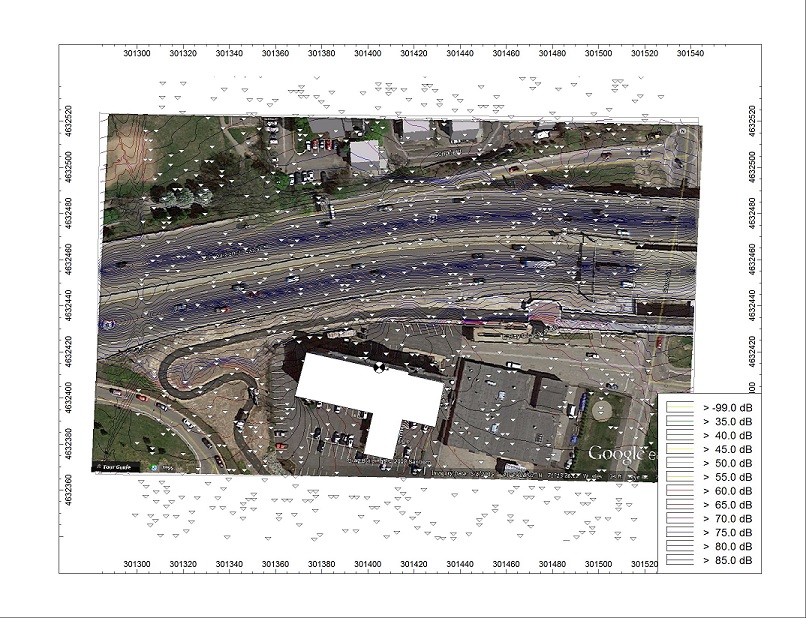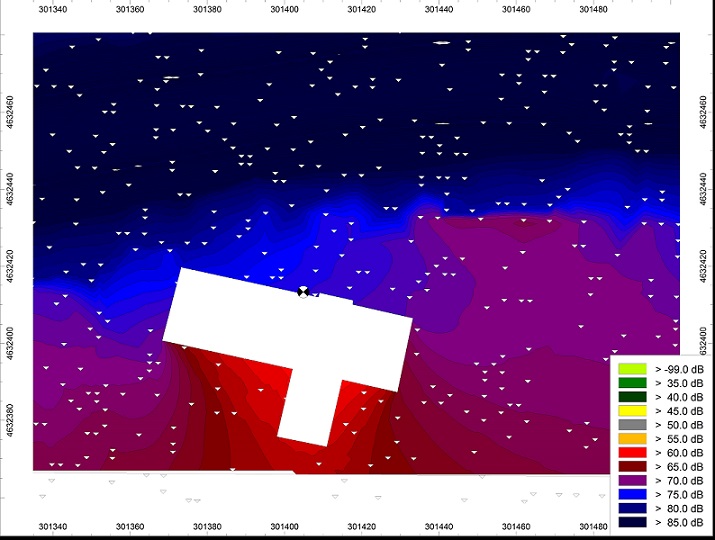
Introduction
The Hilton Gardens Hotel in Providence, Rhode Island has the heavily trafficked Interstate 195 on one side and the Providence Harbor on the other side. The photo above is from the harbor vantage point. This in turn causes excessive interior noise on the highway side and acceptable interior noise on the harbor side. The aim of this study was to determine what sound insulation treatments would be required to achieve acceptable interior noise levels on the highway side of the building. To achieve this, the following steps were taken:
1. A DCC acoustical engineer conducted multiple days of continuous highway noise measurements by installing a noise monitor on the roof of the building. This data was used to determine the worst-case noise exposure.
2. An acoustic model of the site was developed to determine the variation of noise levels along the building façade, both laterally and vertically. This information is needed to determine if some floors or sections require more robust treatments than other areas.
3. Highway noise measurements were made just outside the window of a 2nd floor test unit and just inside the window of the same unit. This data was used to determine the existing Noise Level Reduction (NLR) provided by the existing windows/façade/unit ventilator.
4. The existing NLR was tested again by using a test loudspeaker to ensure both the consistency of the test noise source and overall loudness.
5. Based on the results of 1-4, acoustic modeling was performed to determine the types and amount of noise reduction that would be needed via sound insulation treatments.
Highway Noise Measurements
Figure 1 shows the results of continuous noise monitoring on the roof from 9-13-16 to 9-15-16. Noise levels range from 72 dBA in the early hours of the morning to a high of 81.4 dBA during the morning rush hour. The value of 81.4 dBA will be used as a baseline for the design of the sound insulation treatments.

Acoustic Model of the Site
In order to address the potential variability of noise levels across the building façade, a 3D acoustical model was developed using CADNA- an internationally accepted environmental noise software application. Aerial photographs of the site as well as several thousand elevation points were input into the program. Figure 2 shows the graphical rendition of these inputs.

Finally, the overall octave band sound pressure levels obtained from the highway noise measurements were input into the program. The model was developed so that the calculated noise level at the roof position matched the reference noise level of 81 dBA at the edge of the roof. Figure 3 shows the noise contour results from the modeling. At ground level, the noise level ranges from 78 dBA to 72 dBA from west to east along the building façade. However, at the roof elevation, the range is 81 dBA to 78 dBA. This higher noise level is due to reduced shielding afforded by existing topography at lower elevations.

Figure 4. shows the building façade noise exposure from the profile perspective at the roof top noise measurement position. The noise level ranges from 81 dBA at the roof to 74 dBA at the ground level. As can be seen from the figure, the topography provides significant shielding for the lowest floors.
The conclusion of the CADNA analysis is that while there is variation in noise levels along the façade vertically and laterally, the extent of the range of noise levels is not large enough to justify employing different sound insulation treatments on each floor- for example. In practice, installation of non-uniform treatments would be cumbersome and would likely outweigh any cost savings derived from that approach.

Existing Façade Window/Unit Ventilator Acoustic Testing
DCC conducted two different methods of acoustic testing to determine the existing NLR of the wall, window, and unit ventilator of rooms facing the highway. The two different methods used were 1) using highway noise as the source and 2) using a pink noise source played back through a test loudspeaker. Both methods have pros and cons and produce slightly different results.
For the highway noise measurements, an octave band sound analyzer was positioned just outside the window of a test room on the 2nd floor. Immediately after these measurements were taken, measurements were conducted just inside the window. Since traffic conditions between each measurement were not identical to each other, multiple pairs of measurements were made.
Table 1 shows the average results of this highway noise test.

Because of the limitations of the highway noise test and possible influence of ambient sound sources within the test room, another test was conducted using high sound levels of a pink noise source played back through a test loudspeaker. Table 2 shows the results of this test.

The loudspeaker test revealed that a very noticeable amount of sound was coming into the room through the unit ventilator, but the surface area of the window is much larger and therefore both the window and ventilator are considered major acoustical “flanking paths” into the rooms. The amount of sound leaking into the room is a function of the Transmission Loss (TL) of the façade wall, window, and unit ventilator as well as the surface area of each.
Analysis/Recommendations
An acoustical model of the façade, window, and unit ventilator was developed and based on the NLR measurements, assumed construction of the wall, and window and ventilator details. The acoustical model results were compared with the measured NLR (averaged between the highway and pink noise tests), with reasonable agreement. Various “what if” scenarios can be analyzed by modifying the existing acoustical model with window and unit ventilator treatments.
A treatment consisting of adding a ¼” laminated glass window to the existing window with a 6” sealed airspace between the two glass elements was analyzed. Based on the data collected, treating the window only does not appear to reduce interior noise levels sufficiently, so an acoustical louver for the unit ventilator was also analyzed. No unit ventilator data is available at this time, so it was assumed that a pressure drop of 0.29 at 500 fpm would not interfere with the ventilator performance. The louver analyzed is a Kinetics Noise Control Model KCAL-2, which has a thickness of 6”.
Based on the results of the acoustical model, the expected improvement in the NLR due to these treatments is approximately 6 dBA. This would be a very noticeable improvement and would reduce noise levels to that of the test room on the bay side of the building.
DCC recommends that these (or similar) treatments be installed on the test room. After installation, a staff acoustical consultant would repeat the test procedures to determine actual improvements. Once post-construction test results are confirmed, all units could be outfitted with the recommended treatments.
UPDATE TO STUDY July 11, 2017
DCC conducted acoustical tests of three rooms on the highway side of the Hilton Garden Inn in Providence, Rhode Island. These tests were performed as follow up work to DCC’s “Building Sound Insulation Study Report” dated October 6, 2017. The purpose of the tests was to quantify actual improvement (Noise Level Reduction or NLR) of recommended sound insulation treatments prior to implementing treatments to all the rooms on the highway side. The three test rooms were as follows:
1. Room with upgraded STC 44 window and modified ventilator with improved NLR
2. Room with standard window and modified ventilator with improved NLR
3. Room with no modifications
Table 1 shows the summary results of the tests compared with DCC’s original acoustic model predictions.

As can be seen from Table 1, modeled and actual test results are in excellent agreement with each other. As stated in our October 6, 2017 report, our recommendation of treating both the window and ventilator with an NLR improvement of 6 dBA would essentially cause noise levels in rooms on the highway side to be equivalent to the bay side. We continue to not recommend the “ventilator only” approach since the result is barely above human perception level (3 dBA).
It is interesting that the test of the room with no treatment fell midway between the previous loudspeaker and highway test results which demonstrates the validity of both types of tests (as discussed in the report).